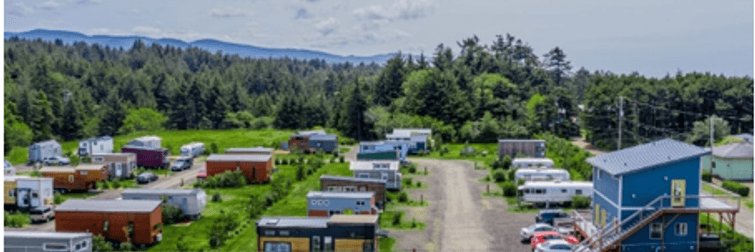
blog: Big Opportunities for Tiny Houses
Tuesday 11th July 2023
Having originated in the United States, and received considerable interest in Australia and New Zealand, in recent years the tiny house movement has gained increasing popularity in the United Kingdom, challenging the conventional notion that bigger housing is better housing. The tiny house movement is an architectural and social movement that is informed by an interest in downsizing, simplifying, and minimising one’s living space with a strong culture of resource sharing and reducing environmental impact. Whilst tiny houses are typically between 60 and 400 square feet, there is no single definition, and its designation is more accurately encapsulated by the philosophy and lifestyle that it promotes.
Benefits
It has emerged as a way of living which offers many social, economic, and environmental benefits (Anson, 2014), as illustrated below:
- Affordability – One of the primary advantages of tiny houses is their affordability. With a lower purchase price, and reduced construction costs, maintenance expenses, and energy bills compared to larger houses, tiny houses can offer significant savings and promote higher levels of home ownership.
- Environmental impact – Another key benefit is their environmental sustainability, where due to their small size, they have a smaller carbon footprint compared to larger, more traditional houses.
- Social impact – Tiny houses can have a positive social impact through promoting a strong sense of community. This form of living forces people to live in close proximity to each other where cooking, washing, and leisure facilities are often shared, within and between houses, which means that people tend to conduct daily activities together.
The Transport Connection
Whilst the benefits of the tiny house movement have largely focused on affordability and lifestyle within academia and the media, the link with transport has received far less attention. Tiny houses can play an important role in inspiring new development to be liveable and support sustainable travel for multiple reasons. One, being small in size, tiny houses can help to maximise the density of developments or can be built in areas of existing high density. Higher density housing can help to create walkable neighbourhoods, reduce reliance on the car, and increase the viability of public and shared transport.
In addition, as tiny houses tend to be conducive to forming strong communities and sharing resources with those you live with or near to, this approach can extend to transportation and promote non-private forms of travel such as car share, shared micromobility, and public transport. Tiny houses tend to attract people who want to downsize and live a more minimalist and sustainable lifestyle, so these developments will naturally interest those who want to travel more sustainably or those who do not rely on a private vehicle or are looking to get rid of one they currently own.
To demonstrate this, one study found that new tiny house residents reported travelling less by car, motorcycle, bus, train, and airplane, driving more fuel-efficient cars than they did before downsizing, and more likely to car share with others (Saxton, 2019). Moreover, Saxton (2019) found that on average ecological footprints were reduced by about 45% after living in a tiny home for a year or more. All five footprint components (food, housing, transportation, goods, and services) were reduced when looking across the study population.
However, it is important to note that some participants reported driving more than they used to, with one of the main reasons being that they lived further away from their jobs and friends. This is why it would be important to incorporate tiny house principles into developments that are sustainably located, near to high-quality public transport and other essential commercial and leisure services.
Reflections
I was able to discuss and develop these ideas further at last month’s 21st Annual Transport Practioners’ Meeting in London, where I presented a poster outlining the opportunities the tiny house movement can offer. I found that there was little awareness of the tiny house movement, however interest in the concept when it was explained in more detail. The movement has received most coverage in media such as blogs, YouTube, and television shows, and increasingly in academia, so it is perhaps unsurprising that it is not as well known in professional circles. For tiny houses to gain more traction in the UK however, it will be crucial to promote it as a viable solution to some of our housing problems, and not just as a lifestyle choice.
Alongside my own discussions, listening to the other presentations at the conference allowed me to reflect on how knowledge and research from other areas of transport and land use planning can complement and further enhance the development of the tiny house movement and its links with sustainable travel. Two points stood out as particularly pertinent:
Collaboration is key
One of the continual threads through the course of conference was the importance of collaboration among professionals; for example, when designing transport interventions, it is critical that separate areas of transport such as cycling, public transport, electric vehicles, and land use planning are not addressed in silos but together so that integration is maximised. This is crucial in the development of tiny houses to ensure they are built in sustainable locations and served by a range of different sustainable transport options.

Behaviour change
One of the key barriers to the uptake of tiny houses are the stereotypes and perceptions that tiny houses would be too small to live in or not ‘the sort of living situation for me.’ In other words, it concerns behaviour change. The conference focused a lot on how the industry can do better to persuade people to make changes to their travel habits, and this can be applied to tiny houses.
The theory of loss aversion asserts that a real or potential loss is perceived by individuals as psychologically more important than the pleasure of an equivalent gain. This increases the fear of making significant lifestyle changes, which is what moving into a tiny house would likely constitute. As such, it is vital to strongly present the opportunities that a change could bring, as people will tend to disproportionally focus on the sacrifices they would have to make. For example, by painting a positive picture, tiny houses can be shown to increase social cohesion and allow individuals to live in a more sustainable and healthy way.
People tend to need capability, motivation, and opportunity to make a change to their lifestyle, and that is why it is important to make the process as seamless as possible by having the right mechanisms in place to encourage these changes. For transport, this could be providing the right incentives, whether that is high-quality infrastructure or services. For tiny houses, this could be updating the planning system to make it more receptive to their development and raising awareness of the movement among the public, local councils, and government. These behaviour change techniques can be applied to further promote the tiny house movement which can help to create more liveable places as well as encourage sustainable travel as a result.
References
Anson, A. (2014) “The world is my backyard”: Romanticization, thoreauvian rhetoric, and constructive confrontation in the tiny house movement. In From sustainable to resilient cities: Global concerns and urban efforts. Emerald Group Publishing Limited.
Saxton, M.W. (2019) The ecological footprints of tiny home downsizers: an exploratory study (Doctoral dissertation, Virginia Tech).
If you'd like to view the original poster as presented at TPM 2023 or any of our other papers please click here.
